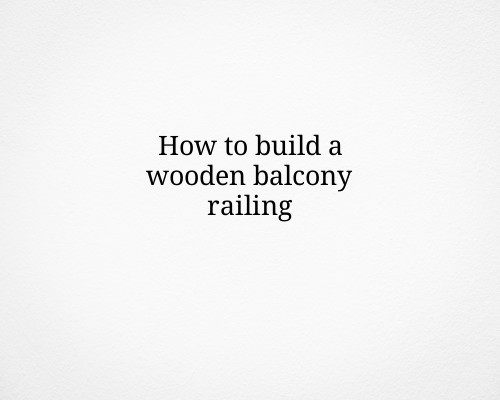Building a wooden balcony railing requires careful planning, measurement, and the right materials to ensure safety and aesthetic appeal. Here’s a step-by-step guide on how to build one:
Materials Needed:
- Pressure-treated lumber for the posts and rails
- Cedar or redwood for the spindles (optional for aesthetics)
- Galvanized screws or deck screws
- Wood glue (optional)
- Post anchors (if not attaching directly to the building)
- Measuring tape
- Saw (circular or miter saw)
- Drill and bit set
- Level
- Carpenter’s square
- Hammer or nail gun (if using nails instead of screws)
- Sandpaper or power sander
- Paint or wood stain (optional)
Step 1: Plan and Measure
The first step is to measure the size of the area where the railing will go. This includes measuring the height from the floor of the balcony to where the top of the railing should be. The standard height for a balcony railing is typically between 36 to 42 inches, depending on local building codes.
Next, measure the length of the area where you’ll install the railing. This will help you calculate how many posts, rails, and spindles (vertical balusters) you’ll need.
Step 2: Choose Your Materials
Select your lumber carefully. Pressure-treated lumber is essential for the posts and horizontal rails, as it will withstand the outdoor elements. Cedar, redwood, or other decorative woods can be used for spindles or balusters. If you plan to paint the railing, ensure the wood is smooth, and consider sanding before starting.
Step 3: Cut the Posts and Rails
- Posts: Cut the posts to the desired height. Make sure they’re long enough to be securely attached to the balcony structure. You will need a post for each corner and every few feet along the railing’s length, depending on local building codes.
- Top and Bottom Rails: Cut the rails to match the length of the space you want to cover. These horizontal pieces should be the same length as the distance between posts.
Step 4: Install the Posts
Start by attaching the posts securely to the edge of the balcony. You can use post anchors for extra stability, especially if you’re not attaching them directly to a structure. To ensure that the posts are level, use a carpenter’s square and level during the installation.
Screw the posts into place with galvanized screws. For maximum strength, make sure that each post is fastened tightly at the base and top.
Step 5: Attach the Bottom and Top Rails
Next, attach the bottom rail (the horizontal piece closest to the balcony floor) and then the top rail (the one that will define the height of the railing). Use screws or nails to secure them to the posts.
To attach the rails, you can either screw them directly into the posts or use brackets to hold them in place. If you’re using screws, drill pilot holes to prevent the wood from splitting. Ensure the rails are level both horizontally and vertically.
Step 6: Install the Spindles (Balusters)
Once the top and bottom rails are secured, it’s time to install the spindles. These vertical pieces should be spaced evenly apart (typically 3-4 inches apart to comply with safety codes). Use a measuring tape to space them consistently.
To attach the spindles, you can either screw them directly into the rails or use wood glue for extra holding power. For a clean finish, you may also want to trim the spindles to the same height as the top rail.
Step 7: Sand and Finish the Railing
After all the components are installed, use sandpaper or a power sander to smooth out any rough edges, especially around the spindles and posts. This will not only make the railing look better but also ensure safety, preventing any splinters or sharp edges.
If desired, you can apply a coat of wood stain or paint to match your outdoor décor or protect the wood from the elements.
Step 8: Inspect and Test the Railing
Before finishing, make sure the railing is secure. Push against it with some force to check for any wobble or instability. If the railing moves, you may need to add additional screws or brackets for reinforcement.
Final Thoughts
Building a wooden balcony railing can be a rewarding project, combining both function and beauty. Make sure to follow local building codes for safety and take your time with measurements and cuts to ensure a secure and attractive finish.
If you’re looking for more woodworking techniques and projects, consider exploring Ted’s Woodworking Course, which provides step-by-step instructions on a variety of woodworking projects: Ted’s Woodworking Course.
